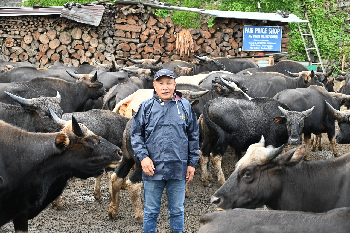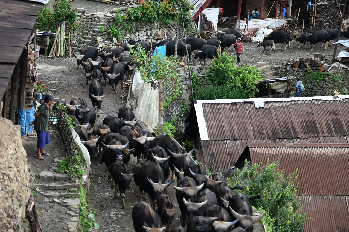Mithun (Bos frontalis) holds immense cultural and economic significance for the tribal communities of Nagaland. Traditionally reared under free-range forest grazing with minimal inputs, Mithun husbandry has been increasingly challenged by shrinking forest cover, disease outbreaks, and calf predation.
Porba village, about 60 km from Kohima and home to the Chakhesang tribe, was among the worst affected. In 2015, a devastating outbreak of Foot-and-Mouth Disease (FMD) reduced the Mithun population from more than 400 to just 60 animals by 2016. Only 10 households continued rearing, and the future of Mithun farming in the village looked uncertain.

To address this crisis, ICAR–National Research Centre on Mithun, Medziphema, in collaboration with Krishi Vigyan Kendra, Phek, introduced a semi-intensive Mithun farming model in 2017.
The approach integrated scientific inputs with traditional practices, focusing on:
•Infrastructure: Construction of night shelters with CGI roofing and barbed-wire enclosures to protect animals from predators and weather.
•Rotational Grazing: Common grazing land divided into three blocks, each used for ~3 months to ensure biomass regeneration and reduce parasite load.
•Health Management: Biannual FMD vaccination, routine deworming, and six-monthly health camps.
•Genetic Upgradation: Introduction of superior breeding bulls, culling of unproductive males, and emphasis on calf care and mineral supplementation.
•Community Organization: Registration of the Porbami Mithun Farmers’ Cooperative Society to oversee collective grazing, herd-book maintenance, and enforcement of village bylaws.
•Capacity Building: Farmers were trained through exposure visits, hands-on camps, and field schools, ensuring widespread adoption of the model.
Results
The intervention produced significant improvements over nine years (2016–2025):
• Herd Size: Recovery from ~60 animals in 2016 to ~240 in 2025.
• Households: Increase from 10 to 48 actively rearing Mithun.
• Disease Control: No major disease outbreaks reported since 2016.
• Calving and Sales: Annual calving reached 20–25; sales stabilized at 15–20 animals per year.
• Market Prices: Female calves now fetch ₹50,000–70,000, while adult males (4–5 years) command ₹1.5–2.0 lakh.
The semi-intensive system also reduced calf mortality, improved animal condition, and enhanced price stability in the market.
The cooperative model strengthened governance, ensured accountability, and enabled collective marketing. Regular shifting of herds between grazing blocks also improved rangeland recovery and reduced parasite cycles. The demand for Mithun meat—valued for its leanness and cultural significance—remains steady, ensuring sustainable income for farmers.
The Porba model highlights the potential of community-led, science-supported livestock systems. Key recommendations for scaling include:
• Inclusion of Mithun-specific components in the National Livestock Mission (NLM).
• Development of region-specific breeding policies.
• Expansion of livestock insurance and credit facilities.
• Support for cold-chain and traceability infrastructure for Mithun meat.
• Community forest agreements for sustainable rotational grazing.

The Porba success story demonstrates that semi-intensive Mithun farming can restore herds after catastrophic losses, expand household participation, and create a resilient rural enterprise. This model effectively combines scientific interventions with community governance while respecting cultural traditions. With supportive policy frameworks, it can be replicated across other Mithun-rearing regions of Northeast India.
Authors: Kobu Khate, M. Chawang, S. S. Hanah, L. Sunitibala Devi, Yallappa S. Somagond, Kezhavituo Vupru, Kathiravan Periasamy, Harshit Kumar, Narendra V. N., Jayanta Chamuah, H. Lalzampuia, Sanjeev Kumar Singh, and Girish Patil S.
(Source: ICAR–National Research Centre on Mithun, Medziphema, Nagaland)








Like on Facebook
Subscribe on Youtube
Follow on X X
Like on instagram